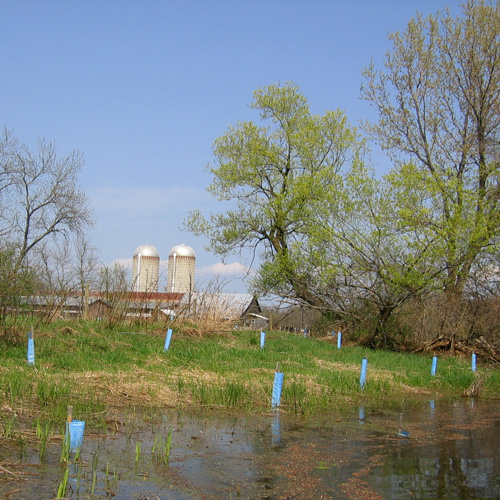Phosphorus Reduction Strategies

Globally, resource management agencies and non-government organizations have developed myriad ways to reduce nutrient pollution into waterways. In the early 1990s, the Lake Champlain Basin Program and partners developed three critical steps in a plan to reduce phosphorus pollution to the Lake. The first step was an agreement among the three jurisdictions (New York, Vermont, and Québec) and the US EPA on the phosphorus concentration goals for the 13 segments of Lake Champlain. Second, a phosphorus “budget” for the Lake was developed and the pollution reductions needed to meet the new phosphorus concentration goals were determined. Third, a cost-optimization procedure to select the most cost-effective reduction strategies was developed and a reduction strategy to achieve the phosphorus concentration goals was selected.
Of additional importance to phosphorus reduction on Lake Champlain were the development of the phosphorus TMDL for the Lake by New York and Vermont and the Missisquoi Bay Phosphorus Agreement between Vermont and Québec.
Establishment of targets for phosphorus concentrations in the Lake
In 1993, New York, Vermont and Québec signed a Water Quality Agreement committing the three entities to use a consistent approach to phosphorus management. The agreement defined in-lake phosphorus concentration criteria (standards) and established a phosphorus concentration target for each of thirteen lake segments. This agreement was renewed in 2010. For more information on the phosphorus targets and actual concentrations for the thirteen lake segments, view the Phosphorus Concentration page and map on the LCB Atlas.
Determination of a Phosphorus Budget
The states of Vermont and New York completed a study to measure point and nonpoint source phosphorus loads to the Lake, develop a whole-lake phosphorus budget, and develop a load reduction strategy to attain the in-lake criteria (Vermont Department of Environmental Conservation and New York State Department of Environmental Conservation, 1994). LCBP reported in the 2018 State of the Lake and Ecosystem Indicators report that annual phosphorus loads lake-wide are now approximately 432 metric tons greater than the established targets. Annual phosphorus loads to the Lake need to be reduced by approximately 50% to achieve the current annual load target of 427 metric tons of phosphorus. Most of this excess load comes from nonpoint sources; loads from point sources (typically wastewater treatment facilities) are now well-below the established targets for this sector.
Source: Vermont Department of Environmental Conservation and New York State Department of Environmental Conservation. 1994. Lake Champlain Diagnostic-Feasibility Study. Final Report Draft 7/1/94. A phosphorus budget, model, and load reduction strategy for Lake Champlain. Waterbury, VT and Albany, NY. 129 pp.
Cost-Effectiveness Strategies
In 1995, Holmes and Artuso developed an optimization procedure to determine the cost-effectiveness of various strategies for achieving in-lake phosphorus criteria (Holmes and Artuso, 1995). Designed for use with the phosphorus model for Lake Champlain, the procedure takes into account the costs of potential phosphorus reductions achievable from agricultural and urban land as well as the manner in which changes to phosphorus levels in each lake segment are expected to affect phosphorus levels in other lake segments. The procedure allows one to sort by cost the possible combinations of point and nonpoint source reductions that could attain the in-lake criteria.
Source: Holmes, T. and A. Artuso. 1995. Preliminary Economic Analysis of the Draft Plan for the Lake Champlain Basin Program. Lake Champlain Basin Program Technical Report No. 12. USEPA, Boston, MA.
Phosphorus Reduction Strategy Selected
In early 1996, representatives from the states of Vermont and New York and US EPA used the phosphorus model and cost optimization procedure to develop a new bistate process for phosphorus reductions. Following extensive analysis of numerous reduction scenarios, the group selected a load reduction process, considered both fair and cost-effective, which was endorsed by the Lake Champlain Management Conference. The agreed-upon process targets 12 of 19 watersheds for phosphorus reductions. Contingent on the availability of federal and/or state funds, each state will reduce the difference between existing (1995) loads and target loads by at least 25% per five-year period for the next 20 years. For more information on the target and actual loads for each lake segment, view the Phosphorus Loads page and map on the LCB Atlas. Also view the Phosphorus Source page in the Atlas for more information about the contribution of phosphorus from different land uses and wastewater treatment facilities.
The States are free to choose the appropriate mix of point and nonpoint source actions to be implemented in each of the watersheds. The States also will have the opportunity to adjust the total loading targets for each of the watersheds, as long as the adjusted loads continue to meet the in-lake phosphorus concentration goals and each state keeps the other state’s allowable loads fixed. The adjusted loads for each state will then be checked together to ensure that the in-lake goals will be achieved.